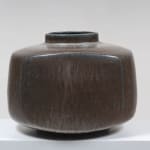


Eva Stæhr-Nielsen
Ceramic
Ceramic
21 x 29 x 25 cm
8 1/4 x 11 3/8 x 9 7/8 in
8 1/4 x 11 3/8 x 9 7/8 in
Saxbo
Further images
Eva Staehr-Nielsen joined SAXBO in 1932. She experimented with many techniques but her best known is called “stengod”, the equivalent of stoneware. She also experimented with over and under-glaze painting...
Eva Staehr-Nielsen joined SAXBO in 1932. She experimented with many techniques but her best known is called “stengod”, the equivalent of stoneware. She also experimented with over and under-glaze painting which is often linked to the salt sandstone technique and applied coatings to her creations using a hammer to change their shape.
Sandstone is the species name for fired clay objects with a high kaolin content, that are becoming gray after firing instead of white. It is also characterized by very a high hardness and an excellent resistance to chemical or climatic attack. This resistance is obtained by cooking at a temperature above 1,200°C a mixture of clay with grains of fine sand, generating a process of vitrification of the clay. The pores fill during the fusion, so the sandstone is no longer porous, making all the difference with terracotta or earthenware.
Eva Staehr-Nielsen used the salt sandstone technique which was used at SAXBO at the same time. This technique involves inducing the formation of a vitreous glaze by projection of sea salt during the final phase of stoneware firing. Under the effect of the heat, the salt decomposes into chlorine, which is evacuated in the form of vapor, and sodium which, by combining with the shard of the pots, forms a very thin layer of a salt glaze. With this technique the pieces are baked raw and without any glaze. The salt glaze combined with the wood firing produces beautiful colors and very rich textures due to the ashes floating in the kiln and settling on the surface of the pieces.
Sign. E.St.N. Made and marked by Saxbo
Sandstone is the species name for fired clay objects with a high kaolin content, that are becoming gray after firing instead of white. It is also characterized by very a high hardness and an excellent resistance to chemical or climatic attack. This resistance is obtained by cooking at a temperature above 1,200°C a mixture of clay with grains of fine sand, generating a process of vitrification of the clay. The pores fill during the fusion, so the sandstone is no longer porous, making all the difference with terracotta or earthenware.
Eva Staehr-Nielsen used the salt sandstone technique which was used at SAXBO at the same time. This technique involves inducing the formation of a vitreous glaze by projection of sea salt during the final phase of stoneware firing. Under the effect of the heat, the salt decomposes into chlorine, which is evacuated in the form of vapor, and sodium which, by combining with the shard of the pots, forms a very thin layer of a salt glaze. With this technique the pieces are baked raw and without any glaze. The salt glaze combined with the wood firing produces beautiful colors and very rich textures due to the ashes floating in the kiln and settling on the surface of the pieces.
Sign. E.St.N. Made and marked by Saxbo


